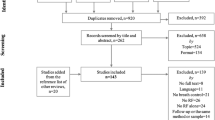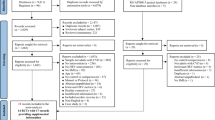Abstract
Low heart rate variability (HRV) characterizes several medical and psychological diseases. HRV biofeedback is a newly developed approach that may have some use for treating the array of disorders in which HRV is relatively low. This review critically appraises evidence for the effectiveness of HRV and related biofeedback across 14 studies in improving (1) HRV and baroreflex outcomes and (2) clinical outcomes. Results revealed that HRV biofeedback consistently effectuates acute improvements during biofeedback practice, whereas the presence of short-term and long-term carry-over effects is less clear. Some evidence suggests HRV biofeedback may result in long-term carry-over effects on baroreflex gain, which is an area most promising for future investigations. On the other hand, concerning clinical outcomes, there is ample evidence attesting to efficacy of HRV biofeedback. However, because clinical and physiological outcomes do not improve concurrently in all cases, the mechanism by which HRV biofeedback results in salutary effects in unclear. Considerations for the field in addressing shortcomings of the reviewed studies and advancing understanding of the way in which HRV biofeedback may improve physiological and clinical outcomes are offered in light of the reviewed evidence.
Similar content being viewed by others
References
Agelink, M., Boz, C., Ullrich, H., & Andrich, J. (2002). Relationship between major depression and heart rate variability: Clinical consequences and implications for antidepressive treatment. Psychiatry Research, 113, 139–149.
Bigger, J., Fleiss, J., Rolnitzky, L., & Steinman, R. (1993). The ability of several short-term measures of RR variability to predict mortality after myocardial infarction. Circulation, 88, 927–934.
Boysen, A., Lewin, M., Hecker, W., Leichter, H., & Uhlemann, F. (2007). Autonomic function testing in children and adolescents with diabetes mellitus. Pediatric Diabetes, 8, 261–264.
Cohen, H., Benjamin, J., Geva, A., Matar, M., Kaplan, Z., & Kotler, M. (2000). Autonomic dysregulation in panic disorder and in post-traumatic stress disorder: Application of power spectrum analysis of heart rate variability at rest and in response to recollection of trauma or panic attacks. Psychiatry Research, 96, 1–13.
Cohen, H., Kotler, M., Matar, M., & Kaplan, Z. (1997). Power spectral analysis of heart rate variability in posttraumatic stress disorder patients. Biological Psychiatry, 41, 627–629.
Cowan, M., Pike, K., & Budzynski, H. (2001). Psychosocial nursing therapy following sudden cardiac arrest: Impact on two-year survival. Nursing Research, 50, 68–76.
Del Pozo, J., Gevirtz, R., Scher, B., & Guarneri, E. (2004). Biofeedback treatment increases heart rate variability in patients with known coronary artery disease. American Heart Journal, 147, G1–G6.
Eckberg, D. L. (2003). The human respiratory gate. The Journal of Physiology, 548, 339–352.
Elliot, W., Izzo, J., White, W., Rosing, D., Snyder, C., Alter, A., et al. (2004). Graded blood pressure reduction in hypertensive outpatients associated with use of a device to assist with slow breathing. Journal of Clinical Hypertension, 6, 553–559.
Giardino, N., Chan, L., & Borson, S. (2004). Combined heart rate variability and pulse oximetry biofeedback for chronic obstructive pulmonary disease: Preliminary findings. Applied Psychophysiology & Biofeedback, 29, 121–133.
Hassett, A., Radvanski, D., Vaschillo, E., Vaschillo, B., Sigal, L., Karavidas, M., et al. (2007). A pilot study of the efficacy of heart rate variability (HRV) biofeedback in patients with fibromyalgia. Applied Psychophysiology & Biofeedback, 32, 1–10.
Joseph, C., Porta, C., Casucci, G., Casiraghi, N., Maffeis, M., Rossi, M., et al. (2005). Slow breathing improves arterial baroreflex sensitivity and decreases blood pressure in essential hypertension. Hypertension, 46, 714–718.
Karavidas, M., Lehrer, P., Vaschillo, E., Vaschillo, B., Marin, H., Buyske, S., et al. (2007). Preliminary results of an open label study of heart rate variability biofeedback for the treatment of major depression. Applied Psychophysiology & Biofeedback, 32, 19–30.
La Rovere, M., Bigger, J., Jr., Marcus, F., Mortara, A., & Schwartz, P. (1998). Baroreflex sensitivity and heart-rate variability in prediction of total cardiac mortality after myocardial infarction. Lancet, 351, 478–484.
La Vaque, T., Hammond, D., Trudeau, D., Monastra, V., Perry, J., Lehrer, P., et al. (2002). Template for developing guidelines for the evaluation of the clinical efficacy of psychophysiological interventions. Applied Psychophysiology & Biofeedback, 27, 273–281.
Lehrer, P. (2007). Biofeedback training to increase heart rate variability. In P. M. Lehrer, R. L. Woolfolk, & W. E. Sime (Eds.), Principles and practice of stress management (3rd ed., pp. 227–248). New York: Guilford.
Lehrer, P., Carr, R., Smetankine, A., Vaschillo, E., Peper, E., Porges, S., et al. (1997). Respiratory sinus arrhythmia versus neck/trapezius EMG and incentive inspirometry biofeedback for asthma: A pilot study. Applied Psychophysiology & Biofeedback, 22, 95–109.
Lehrer, P., Vaschillo, E., Lu, S., Eckberg, D., Vaschillo, B., Scardella, A., et al. (2006). Heart rate variability biofeedback: Effects of age on heart rate variability, baroreflex gain, and asthma. Chest, 129, 278–284.
Lehrer, P., Vaschillo, E., & Vaschillo, B. (2000). Resonant frequency biofeedback training to increase cardiac variability: Rationale and manual for training. Applied Psychophysiology & Biofeedback, 25, 177–191.
Lehrer, P., Vaschillo, E., Vaschillo, B., Lu, S., Eckberg, D., Edelberg, R., et al. (2003). Heart rate variability biofeedback increases baroreflex gain and peak expiratory flow. Psychosomatic Medicine, 65, 796–805.
Lehrer, P., Vaschillo, E., Vaschillo, B., Lu, S., Scardella, A., Siddique, M., et al. (2004). Biofeedback treatment for asthma. Chest, 126, 352–361.
Martinez Lavin, M., Hermosillo, A., Rosas, M., & Soto, M. (1998). Circadian studies of autonomic nervous balance in patients with fibromyalgia: A heart rate variability analysis. Arthritis and Rheumatism, 41, 1966–1971.
McGrady, A. (2007). Psychophysiological mechanisms of stress: A foundation for the stress management therapies. In P. M. Lehrer, R. L. Woolfolk, & W. E. Sime (Eds.), Principles and practice of stress management (3rd ed., pp. 16–37). New York: Guilford.
Muench, F. (2008). The portable StressEraser heart rate variability biofeedback device: Background and research. Biofeedback, 36, 35–39.
Nolan, R., Kamath, M., Floras, J., Stanley, J., Pang, C., Picton, P., et al. (2005). Heart rate variability biofeedback as a behavioral neurocardiac intervention to enhance vagal heart rate control. American Heart Journal, 149, 1137.e1–1137.e7.
Overhaus, S., Rüddel, H., Curio, I., Mussgay, L., & Scholz, O. (2003). Biofeedback of baroreflex sensitivity in patients with mild essential hypertension. International Journal of Behavioral Medicine, 10, 66–78.
Porges, S. W. (2007). The polyvagal perspective. Biological Psychology, 74, 116–143.
Raghuraj, P., & Telles, S. (2008). Immediate effect of specific nostril manipulating yoga breathing practices on autonomic and respiratory variables. Applied Psychophysiology & Biofeedback, 33, 65–75.
Reyes del Paso, G., & González, M. (2004). Modification of baroreceptor cardiac reflex function by biofeedback. Applied Psychophysiology & Biofeedback, 29, 197–211.
Schroeder, E., Liao, D., Chambless, L., Prineas, R., Evans, G., & Heiss, G. (2003). Hypertension, blood pressure, and heart rate variability: The Atherosclerosis Risk in Communities (ARIC) study. Hypertension, 42, 1106–1111.
Swanson, K. S., Gevirtz, R. N., Brown, M., Spira, J., Guarneri, E., & Stoletniy, L. (2009). The effect of biofeedback on function in patients with heart failure. Applied Psychophysiology & Biofeedback, 34, 71–91.
Task Force of the European Society of Cardiology and the North American Society of Pacing and Electrophysiology. (1996). Heart rate variability: Standards of measurement, physiological interpretation and clinical use. Circulation, 93, 1043–1065.
Taylor, J. A., Myers, C. W., Halliwill, J. R., Seidel, H., & Eckberg, D. L. (2001). Sympathetic restraint of respiratory sinus arrhythmia: Implications for vagal cardiac tone assessment in humans. American Journal of Physiology: Heart and Circulatory Physiology, 49, H2804–H2814.
Thayer, J., Friedman, B., & Borkovec, T. (1996). Autonomic characteristics of generalized anxiety disorder and worry. Biological Psychiatry, 39, 255–266.
Vaschillo, E. G., Vaschillo, B., & Lehrer, P. M. (2006). Characteristics of resonance in heart rate variability stimulated by biofeedback. Applied Psychophysiology & Biofeedback, 31, 129–142.
Wang, T., Wu, X., & Huang, Z. (2007). Analysis of the heart rate variability of normal young men in the process of EMG biofeedback. Chinese Mental Health Journal, 21, 212–215.
Watkins, L., Blumenthal, J., & Carney, R. (2002). Association of anxiety with reduced baroreflex cardiac control in patients after acute myocardial infarction. American Heart Journal, 143, 460–466.
Xu, X., Gao, J., Ling, D., & Wang, T. (2007). Biofeedback treatment of prehypertension: Analyses of efficacy, heart rate variability and EEG approximate entropy. Journal of Human Hypertension, 21, 973–975.
Yeragani, V., Rao, K., Smitha, M., Pohl, R., Balon, R., & Srinivasan, K. (2002). Diminished chaos of heart rate time series in patients with major depression. Biological Psychiatry, 51, 733–749.
Zucker, T. L., Samuelson, K. W., Muench, F., Greenberg, M. A., & Gevirtz, R. N. (2009). The effects of respiratory sinus arrhythmia biofeedback on heart rate variability and posttraumatic stress disorder symptoms: A pilot study. Applied Psychophysiology & Biofeedback, 34, 135–143.
Author information
Authors and Affiliations
Corresponding author
Rights and permissions
About this article
Cite this article
Wheat, A.L., Larkin, K.T. Biofeedback of Heart Rate Variability and Related Physiology: A Critical Review. Appl Psychophysiol Biofeedback 35, 229–242 (2010). https://doi.org/10.1007/s10484-010-9133-y
Published:
Issue Date:
DOI: https://doi.org/10.1007/s10484-010-9133-y




